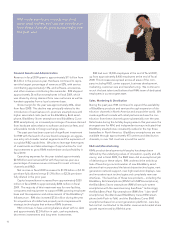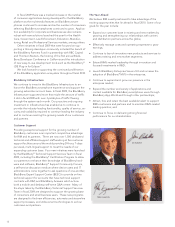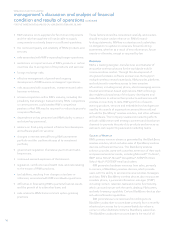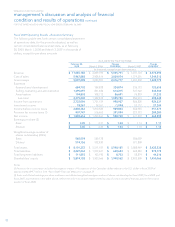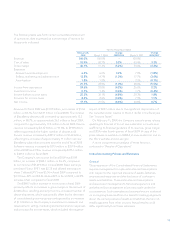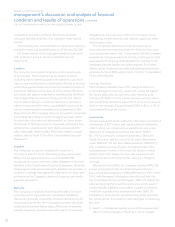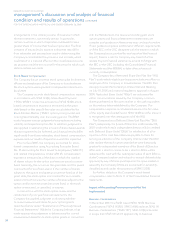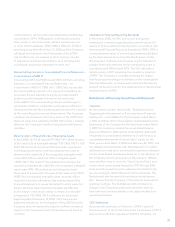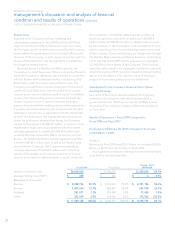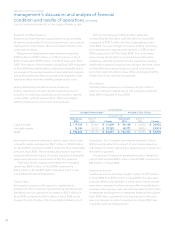Blackberry 2009 Annual Report Download - page 22
Download and view the complete annual report
Please find page 22 of the 2009 Blackberry annual report below. You can navigate through the pages in the report by either clicking on the pages listed below, or by using the keyword search tool below to find specific information within the annual report.RESEARCH IN MOTION LIMITED
management’s discussion and analysis of financial
condition and results of operations continued
FOR THE THREE MONTHS AND FISCAL YEAR ENDED FEBRUARY 28, 2009
20
Service
Revenue is recognized rateably on a monthly basis when the
service is provided. In instances where the Company bills
the customer prior to performing the service, the prebilling
is recorded as deferred revenue. See “Sources of Revenue”
for more information on the calculation of the number of
subscriber accounts.
Software
Revenue from licensed software is recognized at the
inception of the license term and in accordance with SOP
97-2. When the fair value of a delivered element has not
been established, the Company uses the residual method to
recognize revenue if the fair value of undelivered elements
is determinable. Revenue from software maintenance,
unspecified upgrades and technical support contracts is
recognized over the period that such items are delivered or
that services are provided.
Other
Revenue from the sale of accessories is recognized when title
is transferred to the customer and all significant contractual
obligations that affect the customer’s final acceptance
have been fulfilled. Revenue for non-recurring engineering
contracts is recognized as specific contract milestones are
met. The attainment of milestones approximates actual
performance. Revenue from repair and maintenance
programs is recognized when the service is delivered which is
when the title is transferred to the customer and all significant
contractual obligations that affect the customer’s final
acceptance have been fulfilled.
Multiple-Element Arrangements
The Company enters into transactions that represent
multiple-element arrangements, which may include any
combination of hardware, service and software. These
multiple-element arrangements are assessed to determine
whether they can be separated into more than one unit
of accounting or element for the purpose of revenue
recognition. When the appropriate criteria for separating
revenue into more than one unit of accounting is met and
there is vendor specific objective evidence of fair value for
all units of accounting or elements in an arrangement, the
consideration is allocated to the separate units of accounting
or elements based on each unit’s relative fair value. This
vendor specific objective evidence of fair value is established
through prices charged for each revenue element when that
element is sold separately. The revenue recognition policies
described above are then applied to each unit of accounting.
The Company’s critical accounting policies and estimates
have been reviewed and discussed with the Company’s Audit
Committee and are set out below. The Company’s significant
accounting policies are described in Note 1 to the Consolidated
Financial Statements. Except as noted below, there have not
been any changes to the Company’s critical accounting policies
and estimates during the past three fiscal years.
Revenue recognition
The Company recognizes revenue when it is realized or
realizable and earned. The Company considers revenue
realized or realizable and earned when it has persuasive
evidence of an arrangement, the product has been delivered
or the services have been provided to the customer, the sales
price is fixed or determinable and collectability is reasonably
assured. In addition to this general policy, the following
paragraphs describe the specific revenue recognition policies
for each major category of revenue.
Devices
Revenue from the sale of BlackBerry devices is recognized
when title is transferred to the customer and all significant
contractual obligations that affect the customer’s final
acceptance have been fulfilled. For hardware products
for which the software is deemed not to be incidental,
the Company recognizes revenue in accordance with the
American Institute of Certified Public Accountants Statement
of Position 97-2, Software Revenue Recognition (“SOP 97-2”).
Provisions are made at the time of sale for warranties,
royalties, price protection, rebates and estimated product
returns. If the historical data the Company uses to estimate
product returns does not properly reflect future returns,
these estimates could be revised. If future returns are
higher than estimated, they would result in a reduction of
revenue. To date, returns of devices and other products
have been negligible. Price protection is recorded based
on management’s estimate of future price reductions and
certain agreed customer inventory levels. To date, the impact
of price protection has been negligible. Should the actual
experience of price reductions in the future be greater than
the Company’s historical pattern, it would lead to a reduction
in revenue. Rebates and the costs of incentive programs
are recorded as a reduction of revenue based on historical
experience. If the actual volumes applicable to the rebates
and incentive programs in place increase or if additional
incentives are provided to customers, this would result in a
decrease in device revenue.


